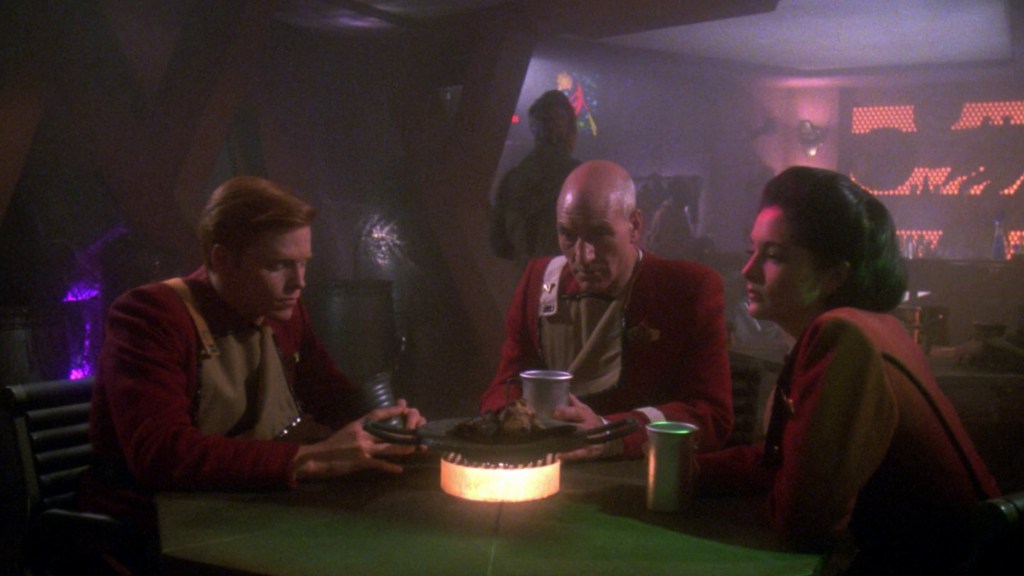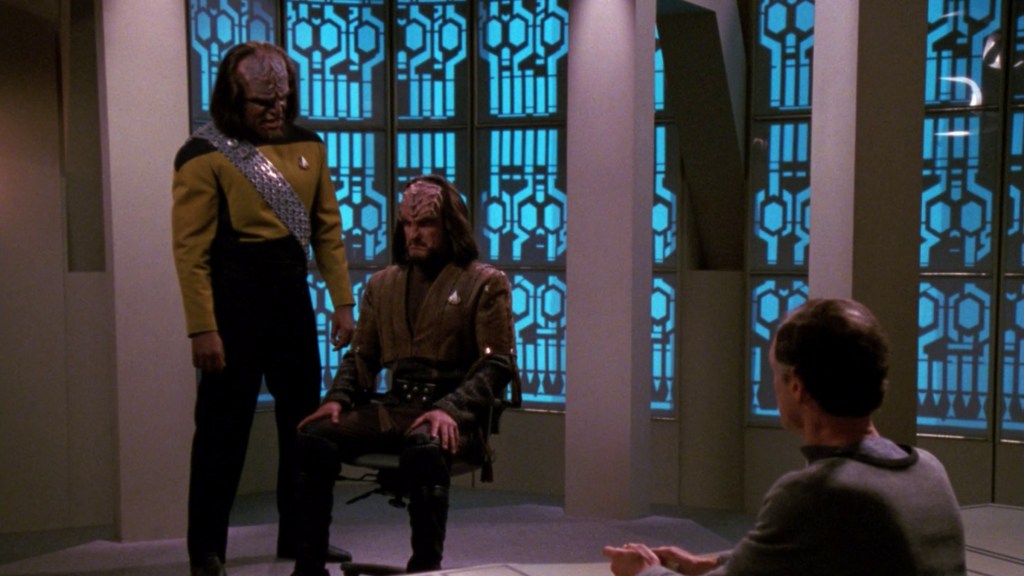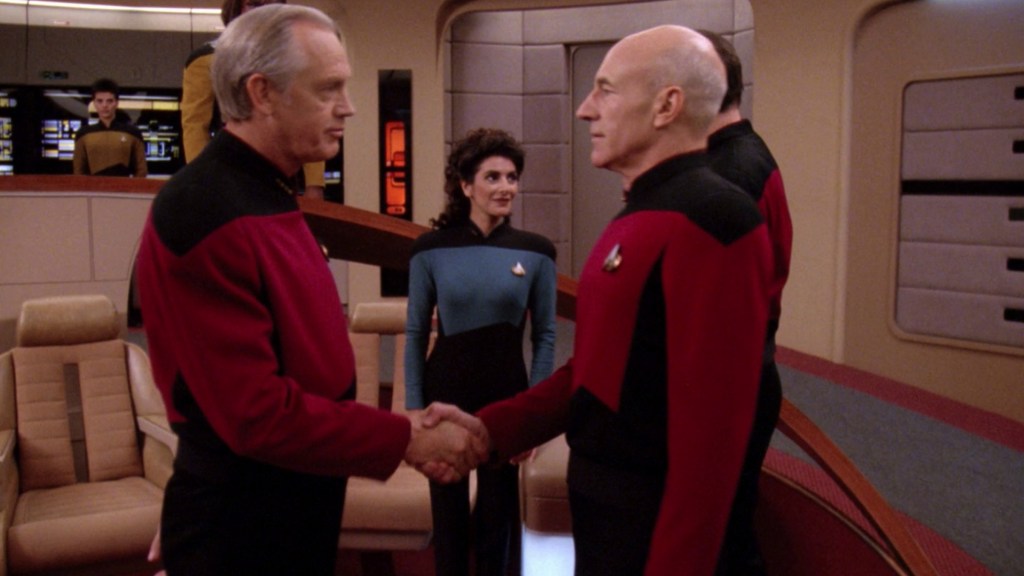Star Trek: The Next Generation took time to find its footing, but by the end of its seven-season run, it had become a thoughtful and emotionally resonant entry in the franchise with its own unique voice. The adventures of Patrick Stewart’s Captain Jean-Luc Picard and the crew of the Enterprise-D expanded the Star Trek universe beyond its borders, delivering stories that remain just as powerful today as when they first aired.
Videos by ComicBook.com
These episodes, whether philosophical showdowns or heartbreaking character pieces, represent the strongest writing, direction, and performances the series ever achieved. Whether you’re revisiting the show or watching for the first time, these ten episodes are essential TNG; each an example of why the series still holds such a firm place in pop culture.
10) “Tapestry”

When Captain Picard dies suddenly after a routine mission goes sideways, he finds himself in a surreal afterlife with Q (John de Lancie), who offers him a second chance to relive a key moment from his reckless youth. What follows is a blend of alternate history and self-reflection, anchored by two of the show’s most iconic performances.
Season 6’s “Tapestry” was written by Ronald D. Moore and has fun with Picard’s Academy days while landing a lasting blow with its message: we are the sum of our regrets. Director Les Landau’s careful pacing and Stewart’s layered performance make “Tapestry” one of the most personal and surprising hours of the series.
9) “The Offspring”

Data (Brent Spiner) builds an android daughter named Lal, but what begins as a hopeful experiment in parenting quickly becomes a heartbreaking examination of rights and autonomy. The Enterprise crew tries to protect Lal, but Starfleet bureaucracy has other plans.
Directed by Jonathan Frakes (who plays Commander Riker), this Season 3 gem was written by René Echevarria and still resonates today for its nuanced exploration of artificial intelligence, family, and institutional control, all while maintaining its emotional core. It’s easily one of Spiner’s best performances in the series. Lal’s final line, “I love you, father,” remains one of the show’s most emotionally devastating moments.
8) “I, Borg”

The Borg return in this iconic episode, but this time not as a threat. When the crew discovers a young, injured drone cut off from the Collective, the question becomes: Can you weaponize someone who’s becoming self-aware? Or should you?
Season 5’s “I, Borg,” also penned by Echevarria, flips the script on one of TNG’s most terrifying enemies. Hugh’s introduction doesn’t just humanize the Borg; it forces the crew, particularly Picard, to confront what vengeance looks like. The episode marked a turning point in how Trek portrayed its villains, opening the door for more nuanced interpretations in Voyager and beyond.
7) “The Drumhead”

What begins as an investigation into a systems failure spirals into a full-blown inquisition in this Season 4 episode written by Jeri Taylor and directed by Frakes. Admiral Satie, played with chilling confidence by Jean Simmons, descends upon the Enterprise looking for enemies, real or imagined. Picard is forced to take a stand for due process and reason.
It’s a standout, and one of the tightest scripts the show ever produced, proving that Trek doesn’t need space anomalies to be compelling. It’s about fear, politics, and how easily liberty can erode under the guise of security. According to fans, the episode’s famous quote: “With the first link, the chain is forged,” has supposedly even been cited in real-world legal arguments.
6) “Chain of Command” (Parts 1 & 2)

Written by Frank Abatemarco for Season 6, this two-parter features Picard being captured and tortured by the Cardassians. Meanwhile, Ronny Cox’s Captain Jellico temporarily takes over the Enterprise and immediately butts heads with the crew. It’s two stories—one physical, one psychological—and both are relentless.
“Chain of Command” delivers one of the most intense, performance-driven arcs in the series. Stewart’s “there are four lights” breakdown is unforgettable, but the political subplot with Jellico adds an extra layer of tension. The minimal sets in Picard’s scenes create a strangely claustrophobic psychological warfare. Notably, this is the only TNG episode where Troi (Marina Sirtis) is seen in a regulation Starfleet uniform.
5) “Darmok”

In this Season 5 episode, Captain Picard is abducted and stranded on a remote planet by the Tamarian people, an alien species whose language is built entirely from metaphor. The universal translator can convert their words, but not their meaning. To communicate, the Tamarian captain, Dathon (Paul Winfield), references mythic stories like “Darmok and Jalad at Tanagra,” hoping shared struggle will forge understanding.
Written by Joe Menosky, “Darmok” is a high-concept episode that has long been a favorite among Trekkies. It’s frustrating and poetic in equal measure, asking the audience to sit with confusion and trust in empathy. The payoff is worth it, and it’s one of the most cited examples of Trek’s commitment to communication over conflict. The alien phrases like “Darmok and Jalad at Tanagra” became instant classics and a fan shorthand for misunderstood unity.
4) “All Good Things…”

In the series finale, Picard finds himself unstuck in time, jumping between three distinct points in his life: the days before the Enterprise-D’s first mission, the present, and a speculative future where the crew has scattered and Starfleet is a memory. The mysterious force behind it all is none other than Q (John de Lancie), who returns to deliver the bombshell that the trial of humanity, which began in the series premiere, never truly ended. As Picard wrestles with his own perceptions and choices, he begins to realize that his actions in all three timelines are interconnected, and that a wrong move could lead to the destruction of all life in the galaxy.
Written by Moore and Brannon Braga, “All Good Things…” caps off Season 7 and the series as a whole with an ambitious and beautifully executed bookend. It’s a rare finale that feels like a reward for longtime viewers while staying true to its characters. The future timeline offers glimpses of what could be, and the finale’s message, that exploration of the self is just as vital as exploration of space, feels like the final thesis of TNG.
3) “The Inner Light”

Captain Picard collapses after being struck by a probe from an unknown alien vessel, and wakes up in another man’s life. On the surface, he’s Kamin, a scientist on the dying planet Kataan. Days turn to years as he slowly accepts this new reality, raising a family, playing music, and watching the slow march of ecological collapse. Meanwhile, just minutes pass aboard the Enterprise.
Written by Morgan Gendel (with teleplay by Gendel and Peter Allan Fields) in Season 5, “The Inner Light” offers one of the most mind-bending premises in all of Star Trek. However, the episode is also emotionally charged, exploring themes of mortality, legacy, and the fragility of memory, anchored by a career-defining performance from Stewart. The Ressikan flute melody Picard learns became a symbol of the life he lost and carries with him forever. Its place in the top three is earned by how it expands the idea of exploration beyond ships and stars, diving instead into the depths of personal identity.
2) “The Best of Both Worlds” (Parts 1 & 2)

The Borg arrive, and nothing is the same after. In this two-parter that bridges the end of Season 3 and the start of Season 4, the stakes skyrocket when Picard is captured and assimilated into the Borg Collective, emerging as Locutus. Frakes’ Commander Riker is left in command, facing an impossible moral crisis. The Season 3 finale ends on a legendary cliffhanger, with the Enterprise preparing to fire on their own captain.
Written by Michael Piller, “The Best of Both Worlds” not only raised the bar for TNG, it redefined what serialized storytelling on TV could look like. It marked a tonal shift for the series and featured the Borg as a terrifying, existential threat. The trauma of Picard’s assimilation would echo for the rest of the series and even into Picard decades later. Both the sheer narrative power and its long-lasting influence on Star Trek have earned the two-parter a top spot.
1) “Yesterday’s Enterprise”

Written by Trent Christopher Ganino and Eric A. Stillwell (with a teleplay by Ira Steven Behr, Richard Manning, Hans Beimler, and Ronald Moore), the best episode of TNG is actually a Season 3 standout. A rift in spacetime pulls the Enterprise-C into the 24th century, altering the timeline so that the Federation is at war with the Klingons, and Tasha Yar (Denise Crosby), long dead in the prime timeline, is still alive. The crew of the Enterprise-D senses something is wrong, especially Whoopi Goldberg’s Guinan, who knows in her bones that history has changed. The only way to restore the timeline is to send the Enterprise-C back to certain doom, reigniting a sacrifice that once ensured peace.
The juggernaut episode combines gripping war drama with a heady moral dilemma that strikes at the heart of Trek. It deepens TNG’s lore, redeems Tasha Yar’s arc, and gives one of the best alternate timeline stories in the franchise. “Yesterday’s Enterprise” earns the top spot for how expertly it gives us a little of everything we want, blending action, character, and philosophy, while showing just how much history can hinge on one selfless act.
All seven seasons of Star Trek: The Next Generation are streaming now on Paramount+.
What’s your pick for the best episode? Let us know in the comments!









